{{currentView.title}}
March 17, 2023
Salafi-Jihadi Movement Weekly Update, March 16, 2023
To receive the Salafi-Jihadi Movement Weekly Update via email, please subscribe here. Follow CTP on Twitter, LinkedIn, and Facebook.
Data Cutoff: March 16, 2023, at 10 a.m.
Contributor: Damaris De La Cruz
Key Takeaways:
Iraq and Syria. ISIS is not defeated, and it will continue to plan attacks against Western targets while setting conditions for a resurgence in Iraq and Syria. The US Central Command (CENTCOM) commander highlighted the continued threat of ISIS efforts to break out prisoners from detention facilities in northeast Syria and sympathizers from internally displaced persons (IDP) camps. A US withdrawal—as suggested by a recent congressional resolution—would inadvertently improve ISIS’s fortunes in Iraq and Syria, where it would focus on freeing veteran cadres and building support in rural areas. A US withdrawal would likely force the Syrian Democratic Forces (SDF) to deprioritize anti-ISIS efforts to counter Syrian regime and Turkish incursions into SDF-controlled areas.
Sahel: Ongoing infighting between al Qaeda and Islamic State–affiliated militants in the Burkina Faso, Mali, and Niger tri-border area that has surged since the French withdrawal from Mali in 2022 will likely increase local support for both groups. Ethnic tensions have played into the clashes and worsened human rights abuses against civilians, forcing locals to support a side for protection. The al Qaeda–linked faction will likely remain the dominant group in the region but be unable to eliminate the Islamic State militants. The resulting stalemate will likely become a self-feeding conflict that will strengthen both sides in the coming months and years.
Afghanistan. Islamic State Khorasan Province (ISKP) is expanding its attack operations in northern Afghanistan. An ISKP suicide bomber killed a top Taliban leader in northern Afghanistan on March 11. Repeated Taliban security failures indicate the Taliban is unlikely to be successful in containing ISKP’s growth in northern Afghanistan.
Pakistan. The Tehrik-e-Taliban Pakistan (TTP) may launch a limited spring offensive on Pakistani security forces. The Hafiz Gul Bahadur TTP faction announced a spring offensive on March 12. Conflicting statements from TTP leadership on a spring offensive could be a result of the Afghan Taliban attempting to restrain the TTP after high-level talks between Pakistan and the Taliban. The TTP leadership’s apparent halt of its spring offensive could lead to fracturing in the organization if the Hafiz Gul Bahadar faction carries out its own offensive.
Assessments:
Iraq and Syria. US CENTCOM Commander General Michael Kurilla traveled to northeast Syria and visited key SDF-controlled detention facilities for ISIS fighters on March 11.[1] General Kurilla also visited Al Hol, which houses 51,000 IDP. Kurilla and CENTCOM reiterated that ISIS fighters in detention facilities are “unrepentant, subject to further radicalization . . . and a ticking time bomb.”[2] CENTCOM also said the population of al Hol Camp represents a “lingering threat” as ISIS sympathizers within the camp aim to indoctrinate and recruit the camp’s 30,000 children.[3]
ISIS is not defeated, and it will continue to plan external attacks against Western targets. The British defense minister said on March 14 that a December drone strike near Al Bab, Syria, targeted an ISIS leader “involved with chemical and biological weapons.”[4] It is unclear if the strike killed the leader, who was taken into custody by Turkish-backed forces, according to a Syrian journalist.[5] ISIS and its predecessors have attempted to acquire chemical and biological weapons to carry out mass casualty attacks against Western targets, most notably in the ISIS chemical weapons lab in Mosul, Iraq.[6]
ISIS is simultaneously setting conditions for a resurgence in Iraq and Syria. The group continues to use rural sanctuaries for attacks against prison facilities.[7] ISIS seeks to free its cadres and sympathizers from prisons and IDP camps to provide veteran fighters to improve its capabilities and a vanguard of supporters.[8] ISIS has plotted to break fighters out from multiple detention facilities since its last successful prison break in January 2022, when it freed 300 fighters.[9] It also attempted to stage a large-scale breakout from Al Hol IDP camp in September 2022, when the SDF disrupted the attack after a premature explosion of a suicide vehicle-borne improvised explosive device (SVBIED) en route to the camp.[10]
The group may have greater latent attack capabilities in Iraq than its recent attack patterns indicate. The Iraqi deputy joint operations commander said on March 12 that only 500 ISIS fighters remain in Iraq, contradicting a recent UN estimate by several orders of magnitude.[11] Pressure from Iraqi counterterrorism forces helps maintain Iraq’s significant gains against the group, but ISIS’s ability to surge attacks during key periods indicates significant latent capabilities.[12] ISIS takes refuge in rural areas, especially those outside the control of Iraqi and Kurdish security forces.[13] ISIS’s ability to establish a training camp—despite the camp’s destruction—points to a concerning level of organization that will permit the group to regroup in rural areas if those areas are not secured.[14]
A US withdrawal from Syria as proposed in a recent war powers resolution would almost certainly improve ISIS’s fortunes in Iraq and Syria.[15] The SDF relies on the United States to enable counterterrorism operations against ISIS and provide diplomatic protection from the Syrian regime and Turkey.[16] The SDF would almost certainly be unwilling and unable to secure detention facilities in Syria as it faced competing priorities from Turkey, ISIS, and the regime.[17] The SDF’s de-prioritization of prisons and IDP facilities would present ISIS with the opportunity to free its veteran fighters and challenge SDF and regime control of the Middle Euphrates River Valley. This would enable ISIS to gradually generate the capacity to threaten the Iraqi state from a sanctuary in Syria.[18] This is not a new strategy; ISIS used Syria as an incubator for its forces in 2013–15 while gradually undermining the Iraqi state.[19]
Figure 1. ISIS Activity in Iraq and Syria in 2023
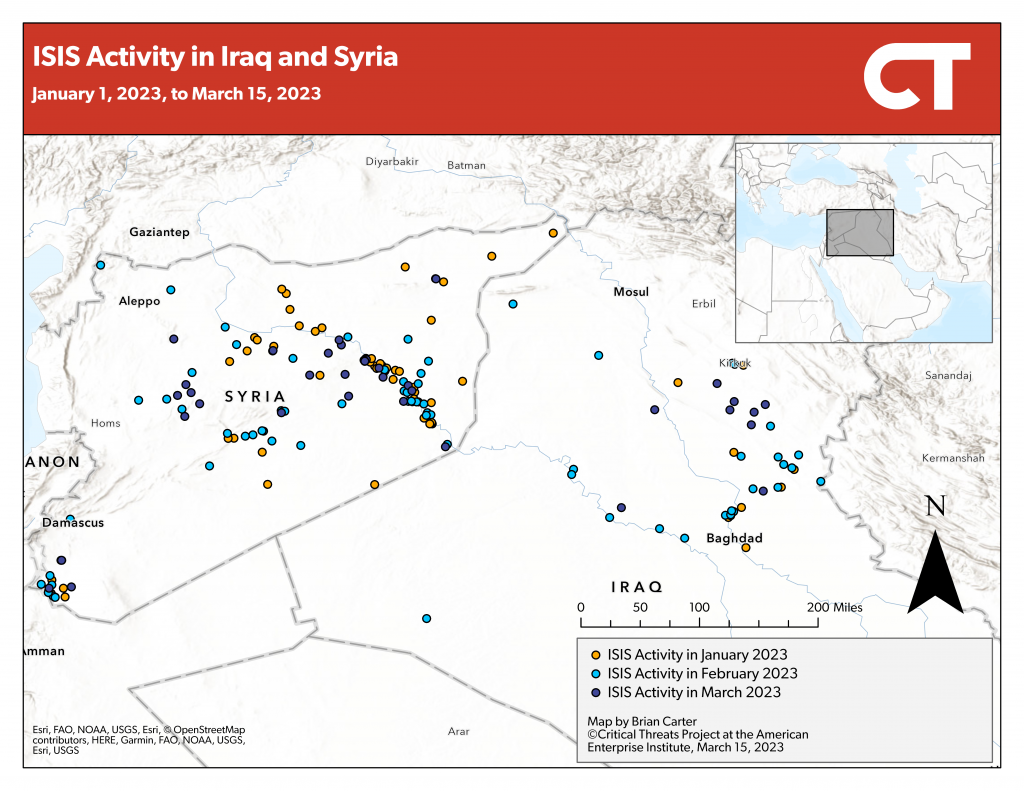
Source: Brian Carter.
Note: CTP defines “attacks” as kinetic activity, including assassinations, armed assaults on military positions, executions, and bombings. “Activity” includes all forms of ISIS activity, including attacks, force movements, and reports of governance activity like zakat collection. ISIS does not generally report on these non-kinetic activities and does not claim all of its attacks.
Figure 2. The Salafi-Jihadi Movement in the Middle East
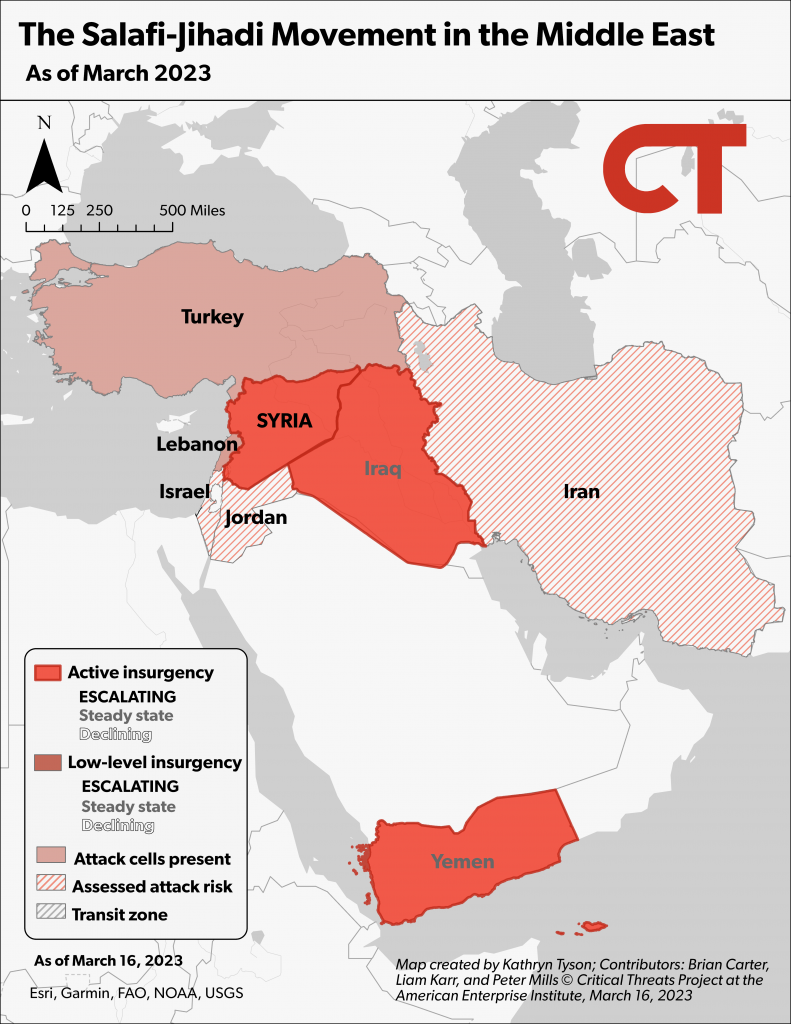
Source: Kathryn Tyson.
Sahel. Al Qaeda in the Islamic Maghreb affiliate Jama’at Nusrat wa al Muslimeen (JNIM) and the Islamic State’s Sahel Province (ISGS) have clashed several times in northeastern Mali since late February 2023. The recent clashes are part of a surge in inter-jihadi violence between the two groups that began in the last quarter of 2022 following the French withdrawal from Mali.[20] The French drawdown in Mali throughout 2022 created a security vacuum that allowed ISGS to expand across northeastern Mali. The group simultaneously carried out retaliatory massacres against vulnerable Tuareg communities that had partnered with French forces and have been historical targets for recruitment to al Qaeda–linked groups.[21] JNIM moved to present itself as the only viable security partner for these communities as ISGS attacks approached JNIM-dominated areas of northeastern Mali.[22] These developments brought the groups into widespread conflict by September 2022, as JNIM sought to push back ISGS alongside other local actors in northern Mali.[23]
The groups’ ties to rival ethnic groups in the area have exacerbated the severity of human rights abuses stemming from the infighting. JNIM and ISGS have repeatedly appealed to long-standing tensions between rival Tuareg and Fulani communities in the area to boost recruitment over the past decade. These connections have made the infighting a vehicle for ethnic violence, including massacres of local populations.[24] ISGS has been the primary perpetrator of such abuses, although JNIM has also carried out several retaliatory massacres.[25]
The increasing violence against civilians is strengthening both sides—but primarily JNIM—by forcing locals to align with a group for protection.[26] Salafi-jihadi groups have consistently used human rights abuses by ethnic militias and security forces as a recruitment tool in Africa and around the world.[27] Abuses by rival Salafi-jihadi groups are now having the same impact in the Mali, Niger, and Burkina Faso tri-border region. ISGS’s overzealous behavior both decreases ISGS’s appeal and plays into JNIM’s strategy.[28] The ISGS massacres in northeastern Mali have already driven local leaders and several militia groups, including loyalist groups with ties to the Malian government, to partner with JNIM.[29] Still, the UN assessed in a February 2023 report that ISGS has enhanced its capacity by increasing recruitment among the local Fulani population at risk of retaliatory attacks from JNIM or Tuareg militia groups.[30]
JNIM will likely remain the dominant Salafi-jihadi group in the Sahel. JNIM is comparatively stronger than ISGS, boasting more fighters and money due to more extensive taxation networks and likely greater participation in the kidnap-for-ransom economy.[31] JNIM and its affiliates’ more flexible and community-based approach to co-opting local populations has also shown to be more successful in spreading its influence across its area of operations and even creating counter-ISGS coalitions, such as in the case of northeastern Mali.[32]
JNIM is unlikely to eliminate ISGS and the threat it poses in the tri-border region. French and international counterterrorism operations, combined with infighting with JNIM, were key to degrading ISGS’s capabilities in 2020.[33] However, these international efforts were unable to eliminate ISGS. JNIM cannot fill the capability gap created by the French withdrawal from Mali and the collapse of the regional Sahel G5 counterterrorism force.[34] JNIM is trying to compensate for the loss of international pressure on ISGS by cooperating with local militia groups. This coalition will still likely fail to fill the capability gap, and varying incentives, goals, and relationships could further restrict cooperation and limit the coalition’s effectiveness.[35]
While JNIM’s inability to eliminate ISGS will not end the conflict, it will likely create a self-feeding stalemate that continues to spread human rights abuses and strengthen both groups’ hold over affected communities in the coming months and years. The JNIM-ISGS stalemate will lead to cycles of communal mobilization and violence that will strengthen both groups’ hold over local communities as the two groups seek to protect their constituencies.
Figure 3. JNIM and ISGS Contest the Tri-Border Region
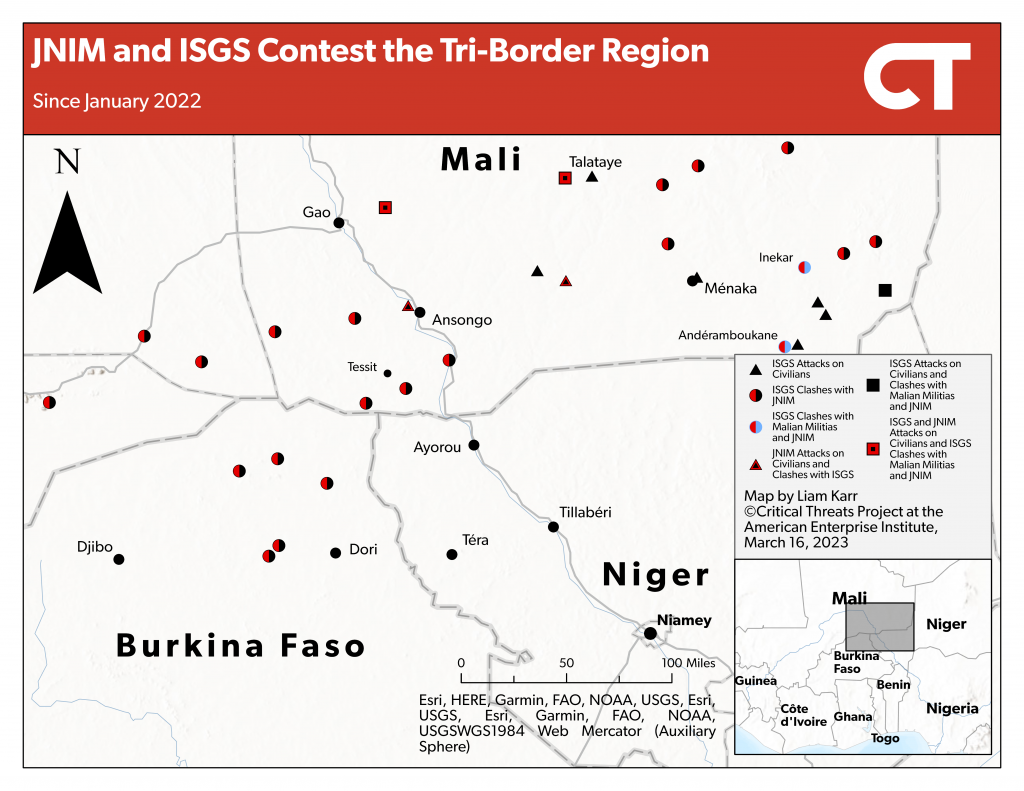
Source: Liam Karr.
Figure 4. The Salafi-Jihadi Movement in Africa
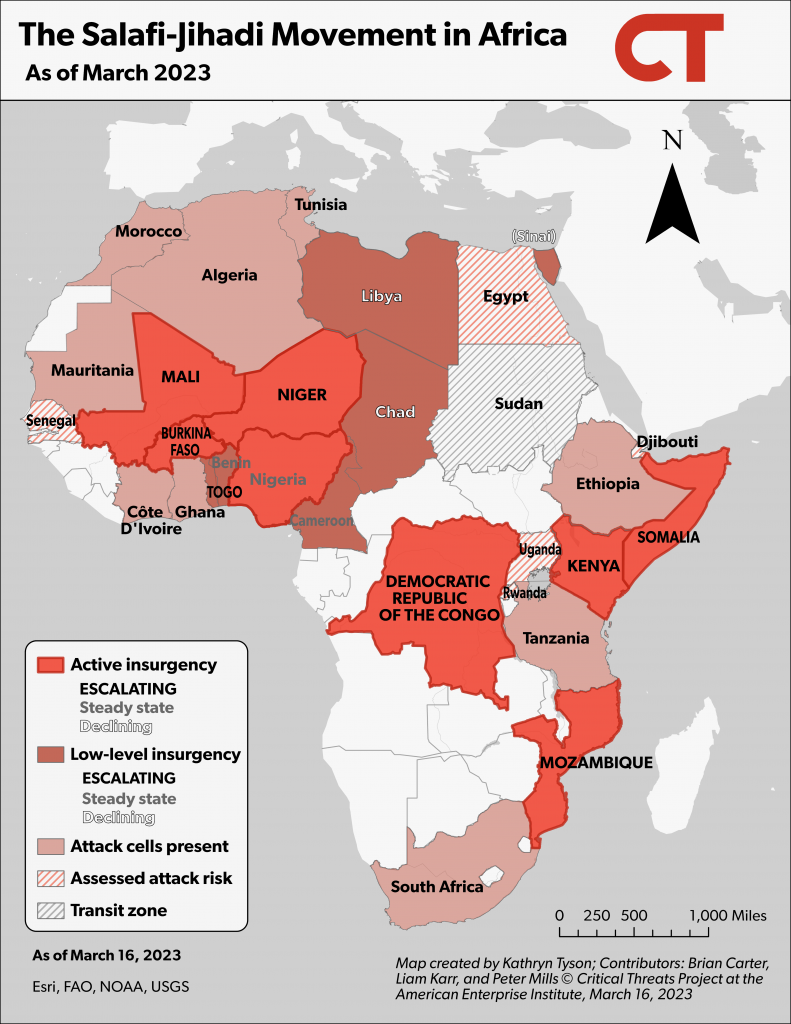
Source: Kathryn Tyson.
Afghanistan. ISKP is expanding attacks in northern Afghanistan. An ISKP suicide bomber killed Taliban Governor of Balkh Province Daud Muzamil at his office in Mazar-e Sharif on March 9.[36] Muzamil previously served as a governor in Nangarhar Province and led Taliban operations against ISKP in eastern Afghanistan.[37] Muzamil shared close tribal and personal ties with the Taliban supreme leader and members of Iranian intelligence.[38] ISKP also claimed credit for a bombing targeting Afghan journalists at a pro-Iran cultural center in Mazar-e Sharif on March 11,[39] assassinated the Taliban police chief for Badakhshan Province in northeastern Afghanistan in late December 2022,[40] and assassinated Taliban officials in Herat and Takhar Provinces in late 2022.[41]
The ISKP suicide bomber who killed Muzamil passed through Taliban security around the governor’s office without being checked.[42] This indicates the bomber was either trusted by Taliban security or had support from ISKP informants in Muzamil’s security, or there were serious lapses in the Taliban’s security for Taliban leaders. As CTP has previously assessed, ISKP infiltration in the Taliban movement will likely hinder an effective Taliban response against ISKP.[43]
Taliban forces executed several people accused of working with ISKP several days after Muzamil’s death in Kunduz Province.[44] It is unclear whether these people were affiliated with ISKP or if the Taliban was lashing out against people suspected of ties to ISKP as revenge for the death of a top Taliban commander. Taliban security forces’ extrajudicial execution of suspected anti-Taliban forces has previously led to protests in Mazar-e Sharif. The Taliban recently raided a warehouse and executed a group of people it claimed were “kidnappers and rebels” in Mazar-e Sharif on March 7.[45] This raid led to protests by family members of the victims, who claimed the victims were civilians working in construction.[46] As CTP has previously assessed, if the Taliban responds to ISKP attacks by lashing out and targeting civilians suspected of affiliation with ISKP, it risks increasing support for ISKP over the long run.[47]
Pakistan. The Hafiz Gul Bahadur group, a Haqqani Network–linked TTP faction, announced a spring offensive on March 12.[48] The faction is based in North Waziristan, northwestern Pakistan. Pakistani journalists reposted a video in late February showing hundreds of TTP militants marching from Afghanistan into unspecified areas in Waziristan.[49] However, CTP cannot verify the date, original source of the video, or whether the individuals are TTP militants. TTP’s leadership council previously announced a spring offensive in March 2022, but it discontinued the campaign after entering into negotiations with the Pakistani government and then announcing a cease-fire with it.[50] The TTP called off the cease-fire in November 2022.[51]
Conflicting statements from TTP leadership on a spring offensive could be a result of the Afghan Taliban attempting to restrain the TTP after high-level talks between Pakistan and the Taliban. TTP leadership has not confirmed the offensive, and the group appears to be divided on whether an offensive will take place. An unidentified senior TTP leader said on March 13 that the TTP would almost certainly not launch an offensive.[52] Pakistan raised the need for the Taliban to address TTP safe havens in Afghanistan during high-level meetings with top Taliban leaders in Kabul, Afghanistan, on February 22.[53] An anonymous Pakistani official said that Pakistan directly requested that the Taliban prevent the TTP from launching another spring offensive.[54] The Taliban said the two sides only discussed economic issues and recent border closures, but the Taliban has never publicly admitted that the TTP has safe havens in Afghanistan.[55] CTP assumes that the talks covered TTP-related security issues.
CTP assesses with low confidence that a separate meeting may have been aimed at Taliban Interior Minister Sirajuddin Haqqani reining in the Hafiz Gul Bahadar faction. Taliban photos from the meeting did not show Haqqani present, despite readouts claiming Haqqani was there.[56] The Pakistani delegation may have held a separate meeting with Haqqani, though Taliban readouts from the meetings did not directly say this. The Hafiz Gul Bahadar group has historical links to Haqqani and operates in historical Haqqani strongholds.[57]
The TTP leadership’s halt of its spring offensive could lead to fracturing in the organization if the Hafiz Gul Bahadar faction carries out its own offensive. The TTP already showed some signs of internal disputes after a major TTP bombing in Peshawar in January 2023.[58] TTP leadership denied the attack after hardline TTP faction Jamaat ul Ahrar (JuA) claimed it, likely because the attack killed civilians. Killing civilians is against TTP’s official code of conduct. JuA had previously criticized the TTP for engaging in peace talks with Pakistan in 2022. TTP divisions also risk some TTP factions joining the Islamic State affiliate in Afghanistan, ISKP. JuA has cooperated in attacks with ISKP and may maintain ties. However, the TTP has resolved similar internal conflicts previously.[59]
Figure 5. The Salafi-Jihadi Movement in Central and South Asia
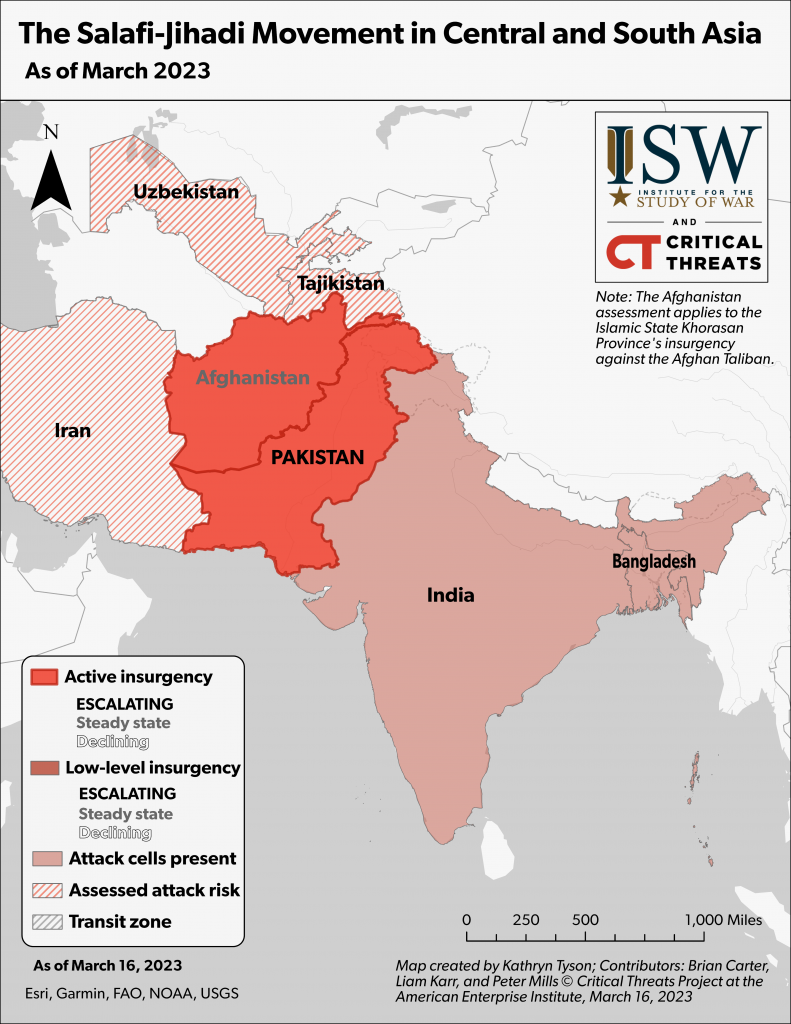
Source: Kathryn Tyson.
Other Updates:
Africa
Somalia. Al Shabaab launched an SVBIED attack targeting government officials in southwestern Somalia’s Gedo region on March 14.[60] The attacker drove the vehicle into a guesthouse where government officials had gathered to discuss counterterrorism recruitment and operations.[61] Somali media reported the attack killed at least nine people and injured 11 others, including the Gedo governor.[62] Al Shabaab claimed it killed at least 13 people and framed the attack as a preemptive strike on Somali officials planning to launch a campaign in al Shabaab–controlled areas.[63] CTP continues to assess that al Shabaab will launch more retaliatory attacks in response to the Somali Federal Government’s impending counterterrorism offensive in southern Somalia in the coming months.[64]
[1] https://twitter.com/CENTCOM/status/1634552733913980930?s=20
[2] https://twitter.com/CENTCOM/status/1634552733913980930?s=20
[3] https://twitter.com/CENTCOM/status/1634552733913980930?s=20
[4] https://www.gov.uk/government/news/update-air-strikes-against-daesh; https://www.theguardian.com/world/2023/mar/14/uk-refuses-to-say-if-it-investigated-reports-of-syria-drone-strike-casualties
[5] https://twitter.com/DeirEzzore/status/1605131901123133441?s=20&t=tteaTCtfTQn33OPQJqTD4w
[6] https://www.washingtonpost.com/national-security/2022/07/11/isis-chemical-biological-weapons; https://pandorareport.org/2014/10/24/isis-and-chemical-weapons; https://www.politico.com/news/magazine/2021/02/27/red-line-book-excerpt-chemical-weapons-syria-471784; https://www.washingtonpost.com/national-security/isis-chemical-weapons-experiments-mosul/2021/05/13/bbfebfb0-b42e-11eb-a980-a60af976ed44_story.html; https://www.cnn.com/2016/09/13/politics/isis-chemical-weapons-plant/index.html
[7] https://www.criticalthreats.org/analysis/isis-will-leverage-improved-attack-capabilities-to-generate-forces-in-syria
[8] https://www.criticalthreats.org/analysis/isis-will-leverage-improved-attack-capabilities-to-generate-forces-in-syria; https://kyleorton.substack.com/p/abu-umar-al-muhajir-third-speech-sept-2022
[9] https://ctc.westpoint.edu/a-prison-attack-and-the-death-of-its-leader-weighing-up-the-islamic-states-trajectory-in-syria
[10] https://www.centcom.mil/MEDIA/STATEMENTS/Statements-View/Article/3167612/us-central-command-statement-on-thwarted-suicide-bomber-attack-near-um-fakik-vi
[11] https://www.al-monitor.com/originals/2023/03/500-fighters-still-active-iraq-military#ixzz7vmFREkYf
[12] https://musingsoniraq.blogspot.com/2023/03/security-in-iraq-mar-1-7-2023.html; https://www.washingtoninstitute.org/policy-analysis/back-basics-us-iraq-security-cooperation-post-combat-era
[13] https://shafaq dot com/ar/%D8%A3%D9%85%D9%80%D9%86/%D8%A7%D9%84%D8%A8%D9%8A%D8%B4%D9%85%D8%B1%D9%83%D8%A9-%D8%AA%D8%AD%D8%B0%D8%B1-%D9%85%D9%86-%D9%85%D8%B5%D8%A7-%D8%AF-%D9%85%D9%88%D8%AA-%D8%A8%D9%8A%D9%86-%D9%82%D9%84%D9%8A%D9%85-%D9%83%D9%88%D8%B1%D8%AF%D8%B3%D8%AA%D8%A7%D9%86-%D9%88%D9%85%D8%AD%D8%A7%D9%81%D8%B8%D8%A9-%D8%B9%D8%B1%D8%A7%D9%82%D9%8A%D8%A9
[14] https://www.al-monitor.com/originals/2023/03/500-fighters-still-active-iraq-military#ixzz7vmFREkYf
[15] https://apnews.com/article/congress-syria-troop-withdrawal-matt-gaetz-609353065981287eac3060c7eb6d9f09
[16] https://www.criticalthreats.org/analysis/salafi-jihadi-movement-weekly-update-january-18-2023; https://media.defense.gov/2023/Feb/07/2003157209/-1/-1/1/LEAD%20INSPECTOR%20GENERAL%20FOR%20OIR.PDF
[17] https://www.criticalthreats.org/analysis/isis-will-leverage-improved-attack-capabilities-to-generate-forces-in-syria
[18] https://www.criticalthreats.org/analysis/isis-will-leverage-improved-attack-capabilities-to-generate-forces-in-syria
[19] https://www.understandingwar.org/report/al-qaeda-iraq-resurgent
[20] https://www.criticalthreats.org/briefs/africa-file/africa-file-al-qaeda-linked-militants-take-control-in-northern-mali; https://www.criticalthreats.org/analysis/salafi-jihadi-movement-weekly-update-january-25-2023
[21] https://www.criticalthreats.org/briefs/africa-file/africa-file-al-qaeda-linked-militants-take-control-in-northern-mali; https://www.criticalthreats.org/analysis/salafi-jihadi-movement-weekly-update-january-25-2023
[22] https://www.criticalthreats.org/analysis/salafi-jihadi-movement-weekly-update-january-25-2023
[23] https://www.criticalthreats.org/briefs/africa-file/africa-file-al-qaeda-linked-militants-take-control-in-northern-mali
[24] https://www.crisisgroup.org/africa/sahel/niger/289-sidelining-islamic-state-nigers-tillabery; https://www.ushmm.org/m/pdfs/Mali_Report_English_FINAL_April_2018.pdf; https://www.cairn.info/revue-herodote-2019-1-page-43.htm
[25] https://www.hrw.org/news/2022/10/27/mali-coordinated-massacres-islamist-armed-groups; https://www.reuters.com/world/africa/dozens-killed-jihadist-groups-clash-eastern-mali-2022-12-08; https://twitter.com/Amachagh10/status/1600417825008472065?s=20
[26] https://www.criticalthreats.org/briefs/africa-file/africa-file-al-qaeda-linked-militants-take-control-in-northern-mali
[27] https://www.aei.org/wp-content/uploads/2023/02/Secure-Communities.pdf; https://www.aei.org/wp-content/uploads/2022/12/The-Underestimated-Insurgency-Continued-Salafi-Jihadi-Capabilities-and-Opportunities-in-Africa.pdf; https://www.criticalthreats.org/analysis/we-must-do-more-than-over-the-horizon-to-fight-terrorism; https://www.criticalthreats.org/wp-content/uploads/2019/10/Beyond-Counterterrorism.pdf; https://www.criticalthreats.org/analysis/how-ansar-al-islam-gains-popular-support-in-burkina-faso
[28] https://ctc.westpoint.edu/the-end-of-the-sahelian-anomaly-how-the-global-conflict-between-the-islamic-state-and-al-qaida-finally-came-to-west-africa
[29] https://www.criticalthreats.org/briefs/africa-file/africa-file-al-qaeda-linked-militants-take-control-in-northern-mali
[30] https://undocs.org/Home/Mobile?FinalSymbol=S%2F2023%2F95&Language=E&DeviceType=Desktop&LangRequested=False
[31] https://eeradicalization.com/jihadist-competition-and-cooperation-in-west-africa; https://acleddata.com/2023/01/13/actor-profile-the-islamic-state-sahel-province; https://issafrica.org/iss-today/abductions-the-hidden-face-of-malis-crisis
[32] https://undocs.org/Home/Mobile?FinalSymbol=S%2F2023%2F95&Language=E&DeviceType=Desktop&LangRequested=False; https://www.criticalthreats.org/analysis/how-ansar-al-islam-gains-popular-support-in-burkina-faso; https://www.criticalthreats.org/briefs/africa-file/africa-file-al-qaeda-linked-militants-take-control-in-northern-mali
[33] https://acleddata.com/2021/06/17/sahel-2021-communal-wars-broken-ceasefires-and-shifting-frontlines
[34] https://www.lemonde.fr/en/international/article/2022/05/18/mali-s-departure-from-the-g5-sahel-signs-de-facto-the-organization-s-death-warrant_5983848_4.html
[35] https://acleddata.com/2023/01/13/actor-profile-the-islamic-state-sahel-province; https://www.criticalthreats.org/analysis/salafi-jihadi-movement-weekly-update-march-8-2023; https://www.criticalthreats.org/briefs/africa-file/africa-file-al-qaeda-linked-militants-take-control-in-northern-mali
[36] https://twitter.com/TajudenSoroush/status/1633898045417897998
[37] http://azamnews dot com/?p=106901
[38] https://home.treasury.gov/news/featured-stories/treasury-and-the-terrorist-financing-targeting-center-partners-sanction; https://twitter.com/Natsecjeff/status/1633772024366608385
[39] https://twitter.com/bsarwary/status/1634455620228186114; https://www.khaama dot com/several-journalists-injured-in-blast-in-afghanistans-balkh-province; https://twitter.com/AfghanAnalyst2/status/1634936614232395777
[40] https://www.reuters.com/world/asia-pacific/afghanistan-car-blast-kills-provincial-police-chief-two-others-2022-12-26
[41] https://www.understandingwar.org/backgrounder/salafi-jihadi-movement-weekly-update-march-8-2023; https://twitter.com/TajudenSoroush/status/1584101696619581440
[42] https://twitter.com/cozyduke_apt29/status/1633825508789227525
[43] https://www.criticalthreats.org/analysis/salafi-jihadi-movement-weekly-update-february-8-2023
[44] https://twitter.com/AfghanAnalyst2/status/1633901980966895652; https://twitter.com/r_auzir/status/1633874550180937759
[45] https://twitter.com/MohammadAsifWa7/status/1633289989617270784
[46] https://twitter.com/Mukhtarwafayee/status/1634143592947109891
[47] https://www.understandingwar.org/backgrounder/salafi-jihadi-movement-weekly-update-march-8-2023
[48] https://twitter.com/SaleemMehsud/status/1634843564793532416
[49] https://twitter.com/ShabbirTuri/status/1627708025577566211; https://twitter.com/SaleemMehsud/status/1627723644053880837; https://twitter.com/SaleemMehsud/status/1627723644053880837
[50] https://twitter.com/SaleemMehsud/status/1509142752633802754; https://thediplomat.com/2023/03/will-the-taliban-regime-dislodge-ttp-from-af-pak-border-areas; https://twitter.com/SaleemMehsud/status/1532414669469757441?s=20&t=cZxIUVLhN3JOYDVGCzbEjA
[51] https://www.criticalthreats.org/analysis/salafi-jihadi-movement-weekly-update-february-1-2023
[52] https://twitter.com/khorasandiary/status/1635319742130003979
[53] https://twitter.com/Pak_AfgAffairs/status/1628425892199337989
[54] https://twitter.com/khorasandiary/status/1628636130143772673
[55] https://www.aljazeera.com/news/2023/2/22/pakistan-defence-minister-isi-head-discuss-security-with-taliban
[56] https://twitter.com/FDPM_AFG/status/1628332270724554752
[57] https://warontherocks.com/2021/11/the-haqqani-network-afghanistans-new-power-players; https://www.theguardian.com/world/2010/oct/06/key-players-afghan-peace-process
[58] https://www.criticalthreats.org/analysis/salafi-jihadi-movement-weekly-update-february-1-2023
[59] https://www.rferl.org/a/pakistan-taliban-ttp-khan-/31488436.html
[60] https://www.criticalthreats.org/briefs/gulf-of-aden-security-review/gulf-of-aden-security-review-march-15-2023
[61] https://apnews.com/article/somalia-extremism-05c1f660e008a17bcc6460b4d01d6eff; https://www.caasimada dot net/al-shabab-targets-somalia-officials-in-deadly-attack
[62] https://apnews.com/article/somalia-extremism-05c1f660e008a17bcc6460b4d01d6eff; https://www.caasimada dot net/al-shabab-targets-somalia-officials-in-deadly-attack
[63] SITE Intelligence Group, “Shabaab Claims Preemptive Strike on Somali Officials in Coordinated Suicide Bombing and Mortar Shelling in Bardhere,” March 14, 2023, available by subscription at www.siteintelgroup.com
[64] https://www.criticalthreats.org/analysis/salafi-jihadi-movement-weekly-update-march-8-2023
